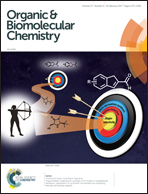Reversal of the sense of enantioselectivity between 1- and 2-aza[6]helicenes used as chiral inducers of asymmetric autocatalysis†
Abstract
Reversal of the sense of enantioselectivity was observed between 1-aza[6]helicene 2 and 2-aza[6]helicene 3 employed as chiral inducers of asymmetric autocatalysis of pyrimidyl alkanol. In the presence of (P)-(+)-1-aza[6]helicene 2, the reaction of pyrimidine-5-carbaldehyde 1 with diisopropylzinc afforded, in conjunction with asymmetric autocatalysis, (S)-pyrimidyl alkanol 4 with high ee. Surprisingly, the reaction in the presence of (P)-(+)-2-aza[6]helicene 3 gave the opposite enantiomer of (R)-alkanol 4 with high ee. In the same manner, (M)-(−)-2 and (M)-(−)-3 afforded (R)- and (S)-alkanol 4, respectively. The sense of enantioselectivity is controlled not only by the helicity of the azahelicene derivatives but also by the position of the nitrogen atom.
![Graphical abstract: Reversal of the sense of enantioselectivity between 1- and 2-aza[6]helicenes used as chiral inducers of asymmetric autocatalysis](/en/Image/Get?imageInfo.ImageType=GA&imageInfo.ImageIdentifier.ManuscriptID=C6OB02745H&imageInfo.ImageIdentifier.Year=2017)


 Please wait while we load your content...
Please wait while we load your content...